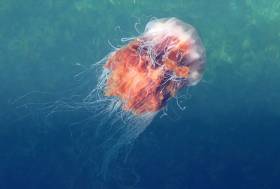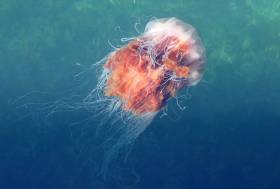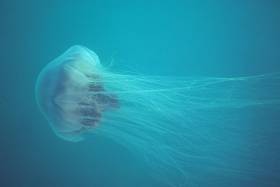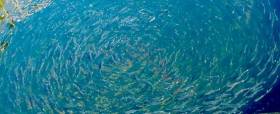Displaying items by tag: Jellyfish
32 Per Cent Increase in Jellyfish Sightings Recorded by Marine Conservation Society
There was a 32 per cent increase in sightings of jellyfish around Irish and British waters over the past year, the Marine Conservation Society (MCS) says.
Barrel jellyfish were the most common, according to its annual wildlife sightings report, with 467 sightings in total.
Crystal jellies, comb jellies, and “sea gooseberries” accounted for about ten per cent of the total.
Cornwall and Wales recorded some of the highest figures for the period from October 2022 to September 2023.
As Afloat previously reported, barrel jellyfish which were normally only seen in waters off the southeast Irish coast, were reported last Mayo to be washing up in unusually large numbers along the entire coastline as far as Cork in the past few months.
Sightings were recorded by the National Biodiversity Data Centre (NBDC) from Lough Foyle on the north coast down to west Cork in the south with anecdotal reports of more, according to University College Cork scientist and jellyfish expert Dr Tom Doyle.
Lion's mane, Portuguese man o' war, moon and compass jellyfish were also recorded by the MCS, which has been asking the public to report sightings of jellyfish for the past 20 years.
It reported 12 turtle sightings, four being of the largest sea turtle, the leatherback.
The “science” of the jellyfish sting, what to do if you get stung, and the different species in Irish waters are themes of a dedicated garden at the Bloom festival in Dublin’s Phoenix Park this weekend.
The jellyfish garden has been developed by University College Cork scientist Dr Tom Doyle, botanical artist Shevaun Doherty, and Blarney Castle head gardener and designer Adam Whitbourn.
The garden design, which is funded by Science Foundation Ireland, involves a “Kreisel” aquarium with live moon jellyfish in circular flowing water.
“Kreisel” comes from the German word for “merry-go-round”.
Dr Doyle says he hopes to “take the sting and fear” out of jellyfish generally while also informing the public about the many different types found in these waters and their lifecycle.
“The aim of the garden is to “take jellyfish out of the sea”, and place them in a very different environment – a garden, where we can compare them with plants and flowers so that the viewer sees them in a different and positive light rather than just fear them,” Dr Doyle has said.
Bord Bia Bloom is open from 9 am to 6 pm daily until June 5th at Dublin’s Phoenix Park.
A relative of corals and jellyfish, which can live for thousands of years, has been used to study the developmental potential of adult stem cells.
A research team in the Centre for Chromosome Biology, University of Galway, selected the cnidarian Hydractinia - a creature which is a close relative of jellyfish – for the project.
Cnidarians are a group of animals that includes corals and jellyfish and can be easily grown in the laboratory.
They have regenerative abilities and don’t appear to age during their life span extending over several thousand years.
The study, published in the international journal Current Biology, was led by Professor Uri Frank and PhD student Áine Varley,
They established this animal as a “model organism” for stem cell research, including the development of genetic tools that allow the generation of transgenic animals.
A major question in stem cell biology is the ability of stem cells to generate other cell types, such as neurons and muscle, throughout life, the team explains.
The team says it addressed the problem by transplanting a single stem cell from a donor animal to a recipient.
“The single transplanted stem cell was genetically labelled by fluorescent dyes, making it visible in the tissue of the recipient,” they explain.
After several months, progeny of the single transplanted stem cell gradually displaced the recipient’s own cells, they found.
“Eventually, a complete takeover occurred, thereby the recipient animal became genetically identical to the donor,” they say.
“Cnidarians are known for their exceptional regenerative ability,” Varley said.
“ Many of these animals can regenerate whole bodies from small tissue fragments,” she said.
“ Another unusual feature of cnidarians is the apparent lack of ageing; indeed, some cnidarians, such as corals, are known to live for thousands of years without experiencing any decline in their health,” she noted.
“These fantastic traits, which are uncommon in animals, are thought to depend on a population of adult stem cells that behave like embryonic cells in that they can renew all tissues, continuously,” she said.
“Hydractinia adult stem cells are functionally similar to human embryonic cells,” Prof Frank said.
“ The technology developed in this project allows us easy access to embryonic-like cells in an adult animal. The study has implications on our understanding of how stem cells function to contribute to tissue regeneration,” Frank said.
Beachgoers around Munster have been warned to watch where they step after numerous sightings of a venomous fish that lurks in the sand, as the Irish Examiner reports.
Lesser weevers are small fish, only 15cm in length, but their stinging spines pack a painful wallop — and in rare cases can be potentially fatal.
Kevin Flannery of Dingle OceanWorld says weevers generally avoid spots where people congregate on beaches, but may be encountered off the beaten track — so wearing footwear, even flip-flops, is a must.
And if you’re unlucky enough to step on one, get the affected area under hot water — up to 40 degrees if possible — to help break down the venom. The Irish Examiner has more on the story HERE.
Munster is also the place to be to see swarms of jellyfish that have turned up along the Cork coastline in recent days, according to the Irish Mirror.
Thousands of what are believed to be moon jellyfish have been spotted from Garretstown to Cobh in Cork Harbour, likely attracted by warmer waters to feed on their usual diet of plankton, molluscs — and other jellyfish.
Divers Meet ‘Giant’ Jellyfish Off Cornwall
Divers off the coast of Cornwall captured the remarkable moment when they encountered a ‘giant’ jellyfish the size of a human being.
As the Irish News reports, biologist Lizzie Daly and wildlife cameraman Dan Abbott were filing for the UK’s Wild Ocean Week at the weekend when they came across the barrel jellyfish.
While not rare for a marine wildlife species, Daly says they are more usually “dustbin lid sized” than the enormous specimens Daly and Abbott shared on social media.
Woah!!!!! We went diving in Falmouth yesterday to finish off #WildOceanWeek and came across this GIANT barrel jellyfish! ? What a way to finish off this marine wildlife adventure! ? pic.twitter.com/NNwDelfWyV
— Lizzie Daly (@LizzieRDaly) July 14, 2019
Elsewhere, and going from large to little, TheJournal.ie reports on a potentially lethal encounter an Irishman had with a tiny octopus in Australia.
Tourist John Paul Lennon had been led to believe the minuscule cephalopod he put on his bare arm in the water at Bunaberg, north of Brisbane, was harmless.
But it was actually a blue-ringed octopus, a highly venomous creature whose sting can cause total paralysis.
“It’s been on my mind constantly thinking what could have happened,” he said. “It’s just lucky I didn’t keep it on my arm for the photo.”
An Irish man, who put a blue-ringed octopus on his arm for a photograph, claims he had no idea the animal could kill him. Speaking exclusively to 7NEWS, the 24-year-old says the one that didn’t get away makes for his best fishing tale yet. @ChloeAmandaB #7NEWS pic.twitter.com/qY89sjL53x
— 7NEWS Brisbane (@7NewsBrisbane) July 14, 2019
#Jellyfish - A whopping 157 lion’s mane jellyfish were recorded along the West Coast this summer, according to figures from the National Biodiversity Data Centre.
And as Galway Bay FM reports, more than a third of these sightings (61) were in the Galway area alone.
Swimmers in Galway were first put on alert in June after a number of people were hospitalised by stings from the dangerous marine animal.
Lion’s manes around the Irish coast this year are believed to be larger than usual to due warmers waters as well as an absence of their natural predators.
Meanwhile, the Irish Mirror has news of a ‘ghastly’ find on a Donegal beach in the shape of a partially eaten fish wholly visible inside a jellyfish.
The “savage” remains of what’s thought to be a moon jellyfish — and its final meal — were discovered by Belfast comedian Paddy Raff.
Found this absolute savage of a jellyfish washed up on the beach in Donegal after it had killed and ingested a fish. Even Davy Attenborough would be shook ?#HomicideLifeOnTheBeach pic.twitter.com/bLvUv6RhHt
— Paddy Riff Raff (@paddyraffcomedy) August 27, 2018
Teen Stung By Lion’s Mane Jellyfish Off Louth Beach
#Jellyfish - Ireland’s recent invasion of lion’s mane jellyfish has extended from Galway Bay to the East Coast, where a teenager was hospitalised after a nasty sting in recent days.
Herald.ie reports that 14-year-old Jack Dunne was stung over most of his body after getting entangled in the tentacles of a lion’s mane while swimming with friends off Port Beach, near Togher in Co Louth.
The teen needed “strong antihistamines and anti-inflammatory tablets” to recover from the intense pain of the jellyfish stings, which have the potential to cause death from anaphylactic shock.
Irish Water Safety chief John Leech warned that the dangerous marine species is not normally seen in the Irish Sea till autumn — and may be increased in number due to an absence of their natural predators, sunfish and turtles. Herald.ie has more on the story HERE.
Lion’s mane jellyfish currently being encountered in Irish waters are also larger than usual, according to one animal expert.
Lion’s Mane Jellyfish In Irish Waters Are Larger Than Usual
#Jellyfish - Lion’s mane jellyfish in Irish waters this summer are much larger than usual.
That’s according to zoologist Dr Tom Doyle, who spoke to The Irish Times after a recent spate of incidents that saw swimmers hospitalised by stings from the dangerous marine species in Galway Bay.
“It is not correct to say this is the first time they have been spotted on the west coast, as we had reports for the last two years, but they are particularly large and mature,” said Dr Doyle.
Lion’s mane jellyfish are more commonly seen in the Irish Sea, and reports of larger specimens similar to those off Galway and Clare have come in from North Wales and Liverpool.
Dr Doyle appealed for the public to report any sightings to the National Biodiversity Data Centre as well as the Facebook page for The Big Jellyfish Hunt.
The Irish Times has more on the story HERE.
#Jellyfish - Bathers have been put on alert in Galway Bay after a number of swimmers were hospitalised for stings by lion’s mane jellyfish.
According to the Connacht Tribune, one woman was stung in the face on Saturday 9 June, while two men suffered stings last Tuesday 5 June.
One member of the Galway Triathlon Club spotted a swarm of 10 lion’s mane jellyfish during a recent 4km swim in the bay.
It’s believed to be the first sighting in Galway Bay for almost two decades of the dangerous marine animal, whose hundreds of tentacles can cause potentially lethal anaphylactic shock.
The Connacht Tribune has more on the story HERE.
Jellyfish To Blame For Major Salmon Farm Fish Kill
#Jellyfish - Four-fifths of the farmed salmon stock at Killary Harbour has been lost to fatal jellyfish stings over the last few weeks, according to The Irish Times.
The Marine Institute has confirmed that naturally occurring swarms of the tiny Muggiaea atlantica and the larger mauve stinger are responsible for the deaths of tens of thousands of fish across four fish farms from Connemara to Bantry Bay.
It marks the worst recorded salmon farm fish kill since 250,000 salmon were lost in Northern Ireland in 2008.
Farmed salmon in Connemara alone was worth €38 million in 2016, as the Connacht Tribune reports.
Meanwhile, wild salmon conservationists have also raised concerns over the potential impact of farmed fish that have reportedly escaped into Ireland’s salmon rivers as a result.
The Irish Times has more on the story HERE.





























































